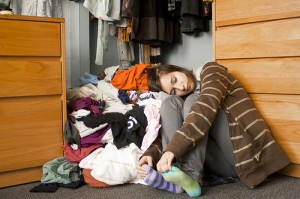Are you staring down a pile of dirty laundry right now (Full Disclosure: I am. Basically always)? Laundry, like dishes, can feel like one of those endless chores. No matter how often you do it, you just keep generating more of it. The clothing that we wear every day should be as toxic-chemical-free as possible; but with our busy schedules (including those endless chores like laundry), detoxing your clothing can feel like a hassle. Luckily, there are easy, budget-friendly ways to make your laundry safer without adding a lot of extra work to your laundry process.
Cool it: Save money, and energy, by lowering the temperature of your washing machine. According to Savvy Brown, 85% of the energy used to wash clothes goes entirely to heating up the water. Cold water is color-safe, gentler on delicates, and a money saver, since lower temperatures can lower your gas bill too. Surprisingly, cold water can also have a positive effect on your indoor air quality. Alexandra Zissu, author of Planet Home, says "heating water blasts volatile chemicals, including chlorine in municipal water, into your breathing space."
Buying laundry supplies: Keep these rules in mind when you stock up on laundry supplies:
- Skip the fragrances: Avoid laundry supplies with fragrances, which may be linked to toxic chemicals like phthalates. Washington Toxics Coalition recommends looking beyond products with Fragrance-Free labels, which may still contain fragrances, and choosing products that list all of their ingredients
- What to look for: The Center for Environmental Health recommends choosing "vegetable-based laundry detergent (made from corn, palm kernel, or coconut oil) that is fragrance-free, dye-free, and does not contain optical brighteners."
- Look it up: Look up products using on-the-go tools like the Good Guide. Learn more about toxic chemicals in popular laundry brands, and cleaning supplies, with this fact sheet from Women's Voices for the Earth.
DIY laundry supplies: Replace a few standard laundry supplies with easy, DIY versions featuring just a few inexpensive ingredients.
- Bleach: Try this tip from Women's Voices for the Earth! Substitute bleach with hydrogen peroxide; Soak your dingy white clothes for 30 minutes in the washer with 1/2 cup 20% peroxide.
- Laundry detergent: Baking soda, castille soap, and water are all you'll need for this DIY detergent recipe.
- Fabric softener: Healthy Child, Healthy World recommends replacing your fabric softener with 1/2 to 3/4 cup of baking soda.
Easy stain removal: Ditch toxic, commercial stain removers (and save a little money) and try out these easy old-school stain removal tips. This infographic shows you how to remove common stains with ingredients like baking soda, lemon juice, and club soda.
Dry cleaning: But what about those dry-cleanables lingering in your closet? Perchloroethylene, a chemical prominently used in dry cleaning, has been linked to cancer as well as nervous system, kidney, liver and reproductive disorders. If it’s not possible for you to give up dry cleaning, there are some easy solutions. Switch from traditional dry cleaning to wet cleaning, which replaces common toxic solvents with biodegradable soap. Debra Lynn Dadd (The Queen of Green) has an outline of which solvents to look out for, and which ones are safe to use. Healthy Child, Healthy World recommends using these two directories to find local, green dry-cleaners.
If you want to stick with your dry cleaner, try to dry clean less items, less frequently. Go through your dry clean only clothing and determine if any of it could be washed by hand instead of sent to the cleaners. And when you bring dry cleaning home, take it out of the plastic and let it off gas outside or in a well ventilated area.
This blog is a part of the Healthy Child, Healthy World blog network.




The views and opinions expressed in this post are those of the author(s) and do not necessarily reflect those of MomsRising.org.
MomsRising.org strongly encourages our readers to post comments in response to blog posts. We value diversity of opinions and perspectives. Our goals for this space are to be educational, thought-provoking, and respectful. So we actively moderate comments and we reserve the right to edit or remove comments that undermine these goals. Thanks!